Amber Valley
Explore hidden histories, historic photos, and things you never knew about Amber Valley from the collections and archives of Historic England.
Discover your local listed buildings and places
Introducing some of Amber Valley's most historic sites, included in the National Heritage List for England. Some of these captions have been summarised by AI. Click through for the official List entry. Skip this section and go to place by numbers
Swanwick Common Colliery Headstock and Winding House
Swanwick
The steel headstock and brick winding house of a small, early-C20 colliery.
Derwent Valley Mills
Alderwasley
The official listing for all World Heritage sites is held by UNESCO and can be found on their website.
Wingfield Station
South Wingfield
Railway station built in 1839-40 to the designs of Francis Thompson for the North Midland Railway.
Wingfield Manor: a medieval great house
South Wingfield
Wingfield Manor, built in the mid-15th century for Ralph, Lord Cromwell, symbolizes the power and luxury of high nobility.
Kedleston Hall
Kedleston
Kedleston Hall, designed by Robert Adam, features gardens and historic developments by the Curzon family dating to the 12th century, now managed by the National Trust.
Portal to Stephenson's Tunnel, Crich
Crich
Tramway tunnel portal built by George Stephenson in 1841.
Butterley Works blast furnaces, canal tunnel and undergro…
Ripley
C19 blast furnaces, late C18 canal tunnel, underground wharf and related mineral extraction works.
Codnor Castle
Aldercar and Langley Mill
Codnor Castle comprises a motte and bailey castle remodelled in stone sat on the eastern perimeter of an upper court, with a lower court to the south.
Park Hall moated site, well and enclosure
Mapperley
Park Hall is a historically significant moated site associated with Simon de Arderne, featuring preserved organic remains and archaeological elements from the 13th century, including pottery...
South East Derbyshire College
Heanor and Loscoe
Secondary school, now college, 1912, with late C20 extension.
Twelfth century tower keep castle, including sites of an …
Duffield
Duffield Castle, a tower keep castle over an earlier motte and bailey, played key roles from the 11th to 13th centuries and featured Roman and Anglian elements.
Derwent Viaduct (SPC8 42)
Ripley
A five-span skew arched viaduct built in 1836-40 for the North Midland Railway to the designs of George and Robert Stephenson with Frederick Swanwick.
Crich Stand (Sherwood Foresters Regimental Memorial)
Crich
War memorial. Erected in 1922-23, after the First World War, to the design of Lieutenant Colonel Brewill by Joseph Payne of Crich. Iron railings and gate added in 1929.
River Gardens
Belper
Public pleasure garden laid out by the River Derwent in 1905 by leading philanthropist associated with Belper's cotton-milling industry.
Castle Farm
Aldercar and Langley Mill
Farmhouse, C16, with C16 and later additions and modifications of stone, timber and brick.
Gibfield Lane Bridge Over Railway
Belper
Amasonry bridge carrying Gibfield Lane, Belper over the Midland Main Line, and an attached section of masonry walling lining the Belper railway cutting.
Bridge over Railway
Belper
The William Street Bridge is one of a series of bridges over the railway line in Belper, Derbyshire and lengths of masonry wall lining the cutting which they span, built for the North...
Horsley Castle tower keep castle
Horsley
Horsley Castle, a 12th-century tower keep castle, features notable defensive structures and historical significance, associated with prominent figures such as the de Buron family and Duke of...
Church of All Saints
South Wingfield
Church of All Saints dates from the 12th century, with notable 19th-century renovations, reflecting its historical and architectural significance.
Walls of Railway Cutting extending from approximately 35 …
Belper
The masonry walls lining the railway cutting passing through the town of Belper inDerbyshire, and a series of associated road bridges spanning the cutting, all form part of the development...
New Road Bridge (SPC8 27)
Belper
A single-span skew overbridge built in 1836-40 for the North Midland Railway to the designs of George and Robert Stephenson with Frederick Swanwick.
King Street Bridge (SPC8 28)
Belper
A single-span skew overbridge built in 1836-40 for the North Midland Railway to the designs of George and Robert Stephenson with Frederick Swanwick, and widened in the 1970sThis list entry...
Church of St Mary
Crich
The Church of St Mary in Cric is a medieval Anglican church with features from the 12th to 20th centuries, known for its decorated tower, chancel, and significant architectural alterations.
Aqueduct, 328m south east of Aqueduct Cottage
Dethick, Lea and Holloway
The aqueduct, dating to the 19th century, showcases architectural and technological innovation and is central to the Cromford Canal and Matlock railway within the Derwent Mills World...
Bridge over Railway
Belper
The Joseph Street Bridge is one of a series of bridges over the railway line in Belper, Derbyshire, and lengths of masonry wall lining the cutting which they span, built for the North...
Bridge over Railway
Belper
The Long Row bridge is one of a series of bridges over the railway line in Belper, Derbyshire and lengths of masonry wall lining the cutting which they span, built for the North Midland...
Footbridge over railway to the west of Pingle Lane (SPC8 34)
Belper
A railway accommodation overbridge forming part of the North Midland Railway Company's line from Derby to Chesterfield, completed in 1840, one of a series of carefully-detailed masonry...
1,2 and 3, Lea Road
Cromford
Late-C18 mill manager's house, extended to form workers' cottages in the C19. Refurbished in the C21.
Alderwasley War Memorial
Alderwasley
A First World War memorial, date of construction unknown, thought to be completed shortly after 1920, with later additions for the Second World War.
Codnor Park and Ironville War Memorial
Ironville
War memorial, erected in 1923. Built by Mr Edward Cope of Riddings.
Bridge over Railway
Belper
The George Street bridge is one of a series of bridges over the railway line in Belper, Derbyshire, and lengths of masonry wall lining the cutting which they span, built for the North...
Explore more
Search for more listed placesAmber Valley through time
This timeline shows the first period of use for buildings and places on the National Heritage List for England, just one of the details recorded for every list entry. Click around to see how Amber Valley changes over time. Skip this section and go to aerial photos
Roman AD 43 to AD 410
Britain was invaded by four legions of the Roman army in AD 43, who relatively rapidly conquered England from landing points in Kent. Parts of Wales and Scotland soon followed.
Roman culture brought urbanism, monumental buildings, wide-ranging religious beliefs, writing, and strong social hierarchy. The Roman administrative system was withdrawn in AD 410.
Early medieval AD 410 to AD 1066
This period, often associated in England with Anglo-Saxons and Vikings, saw a reduction in urban living from the Roman period and increased migration from northern Europe.
Traces of this period can be found in cemeteries, particularly in artefacts and in some of the very early churches, as this period also saw the growth of Christianity in Britain.
Medieval AD 1066 to AD 1540
This period, sometimes known as the Middle Ages, began with the Norman invasion in AD 1066. It saw a significant rise in military and defensive buildings such as castles and earthworks, as well as religious houses dominating a largely agricultural landscape.
The monarchy and Church dominated the period, which also saw the break with the Roman Catholic Church and the English reformation.
Post medieval AD 1540 to AD 1901
The Post-Medieval period brought seismic changes to life in England, with religious reformation leading to the democratization of worship and the destruction of hundreds of religious houses.
In parallel, there was a huge expansion of scientific study and enlightenment that permanently altered the nation's social structure and landscape. Industrialization and mass production lead to wider global trade, emigration, and immigration.
20th century AD 1901 to AD 2000
The 20th century saw an incredible expansion of England's transport networks, with suburban growth shadowing rapid infrastructural expansion. The establishment of state schools, hospitals, and modern technical colleges, with new architectural styles, radically changed the appearance of towns and cities.
Two catastrophic world wars and the 1918 pandemic also brought unprecedented change, altering England's built environment and social structures forever.
Roman AD 43 to AD 410
Britain was invaded by four legions of the Roman army in AD 43, who relatively rapidly conquered England from landing points in Kent. Parts of Wales and Scotland soon followed.
Roman culture brought urbanism, monumental buildings, wide-ranging religious beliefs, writing, and strong social hierarchy. The Roman administrative system was withdrawn in AD 410.
Early medieval AD 410 to AD 1066
This period, often associated in England with Anglo-Saxons and Vikings, saw a reduction in urban living from the Roman period and increased migration from northern Europe.
Traces of this period can be found in cemeteries, particularly in artefacts and in some of the very early churches, as this period also saw the growth of Christianity in Britain.
Medieval AD 1066 to AD 1540
This period, sometimes known as the Middle Ages, began with the Norman invasion in AD 1066. It saw a significant rise in military and defensive buildings such as castles and earthworks, as well as religious houses dominating a largely agricultural landscape.
The monarchy and Church dominated the period, which also saw the break with the Roman Catholic Church and the English reformation.
Post medieval AD 1540 to AD 1901
The Post-Medieval period brought seismic changes to life in England, with religious reformation leading to the democratization of worship and the destruction of hundreds of religious houses.
In parallel, there was a huge expansion of scientific study and enlightenment that permanently altered the nation's social structure and landscape. Industrialization and mass production lead to wider global trade, emigration, and immigration.
20th century AD 1901 to AD 2000
The 20th century saw an incredible expansion of England's transport networks, with suburban growth shadowing rapid infrastructural expansion. The establishment of state schools, hospitals, and modern technical colleges, with new architectural styles, radically changed the appearance of towns and cities.
Two catastrophic world wars and the 1918 pandemic also brought unprecedented change, altering England's built environment and social structures forever.
Aerial photos of Amber Valley
Aerial photography helps reveal secrets of England's changing landscapes that are impossible to see from the ground. Skip this section and go to archive images

South Wingfield
The ruins of Wingfield Manor House and Manor Farm, South Wingfield, 1947
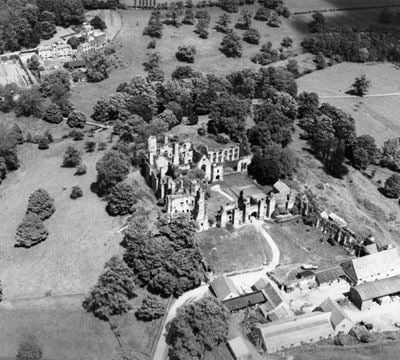
South Wingfield
The ruins of Wingfield Manor House and Manor Farm, South Wingfield, 1947
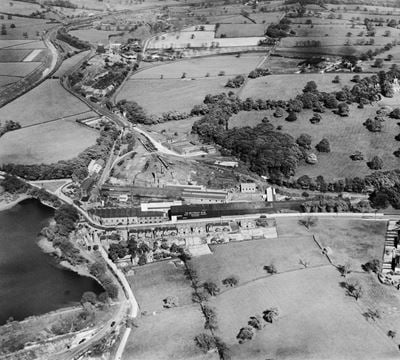
Butterley
The Butterley Co Iron Works, Butterley, 1936
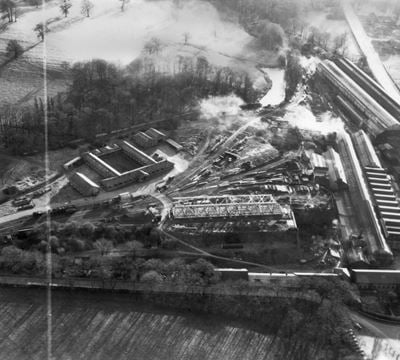
Butterley
The Butterley Iron Works, Butterley, 1947

Smalley
Farmland at Carrington's Farm, Smalley, 1935

Denby Village
Restored opencast mining site north of Carrington's Farm, Denby Village, 1950
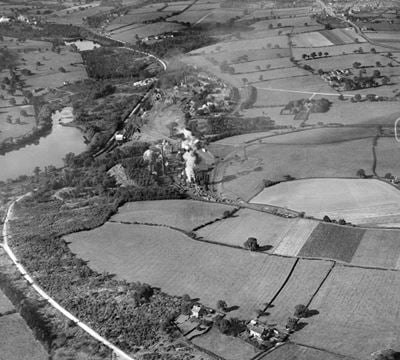
Shipley
Woodside Colliery, Shipley, 1926

Shipley
Woodside Colliery, Shipley, 1926
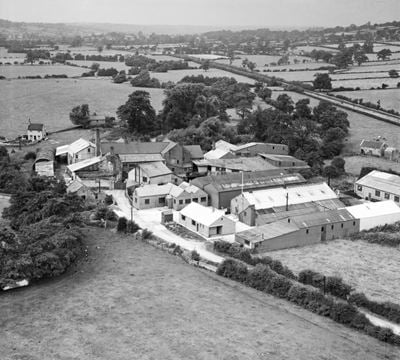
Duffield
The W. Hawley & Son Ltd Colour Works, Duffield, 1946

Duffield
The W. Hawley & Son Ltd Colour Works and Meadows Farm, Duffield, 1946
Amber Valley in the Historic England Archive
The Historic England Archive cares for over 15 million images, dating from the 1850s to the present day. Discover stunning images of Amber Valley's past. Skip this section and go to stories about heritage
Eileen ‘Dusty’ Deste Collection
Amber Valley, Derbyshire
Date created: 1967
Detail of the plaque on the front elevation of the House of Confinement in Alfreton
Eric de Mare
Kedleston Park, Amber Valley, Derbyshire
Date created: 1945 - 1980
General perspective view of the Bridge in Kedleston Park from the river bank.
John Laing Collection
Amber Valley, Derbyshire
Date created: 24 May 1949
A view of excavators extracting coal during opencast mining at Office Site
London, Midland and Scottish Railway Company
Amber Valley, Derbyshire
Date created: 1880 - 1900
A view looking along Lower Road with the gatehouse of Mackworth Castle in the left foreground and two figures conversing outside the adjacent terrace...
Nigel Temple Collection of Postcards of Parks and Gardens
Belper, Amber Valley, Derbyshire
Date created: 1900 - 1910
GENERAL VIEW SHOWING SERPENTINE WALK AND TEA HOUSE
Eileen ‘Dusty’ Deste Collection
Amber Valley, Derbyshire
Date created: 1967
The House of Confinement in Alfreton viewed across King Street with number 148 King Street partially visible to the left of frame
John Laing Collection
Amber Valley, Derbyshire
Date created: 1947 - 1949
An earthmoving vehicle at work at Carrington's Coppice opencast mine
London, Midland and Scottish Railway Company
Whatstandwell, Amber Valley, Derbyshire
Date created: Aug 1913
A view looking north-west along Main Road, past the front of a cottage on the north-east side
Nigel Temple Collection of Postcards of Parks and Gardens
Belper, Amber Valley, Derbyshire
Date created: 1904 - 1909
GENERAL VIEW SHOWING PATH THROUGH THE PARKS
John Laing Collection
Amber Valley, Derbyshire
Date created: circa 1947 - 1949
View of the opencast coal mine at Carrington's Coppice, Derbyshire showing a 178 feet deep cut
London, Midland and Scottish Railway Company
Whatstandwell, Amber Valley, Derbyshire
Date created: Aug 1913
A view looking south-east towards Whatstandwell Bridge and village
Nigel Temple Collection of Postcards of Parks and Gardens
Amber Valley, Derbyshire
Date created: 1895 - 1920
GENERAL VIEW SHOWING SERPENTINE WALK IN GARDENS
Stories about heritage in your local area
Historic England publishes news, blogs, research, videos, and podcasts celebrating England's rich heritage. Discover the stories we have about Amber Valley. Skip this section and go to education
England’s Record Breaking Heritage
Mentions Butterley Gangroad and Fritchley Tunnel
The Guinness World Records celebrates 60 years of extraordinary achievements this week, from globetrotting explorers to sports heroes smashing records.
Heritage Highlights: Where is one of the world’s oldest surviving railway tunnels?
Mentions Butterley Gangroad and Fritchley Tunnel
Fritchley Tunnel Butterley Gangroad, Fritchley, Derbyshire Scheduled: 2015 NHLE entry Who would have thought that, beneath an unassuming junction in...
16 Remarkable Historic Places Listed in 2023
Mentions Swanwick Common Colliery Headstock and Winding House
Take a closer look at the historic gems that were examined, protected and added to the National Heritage List for England in 2023.
£4.5 Million Increase to the Heritage Stimulus Fund
Mentions Wingfield Station
Funding will ensure essential repairs and restoration can be completed as well as supporting thirty-three new historic sites for the first time.
Remembering Passchendaele: War Memorials Listed
Mentions Crich Stand (Sherwood Foresters Regimental Memorial)
Battle of Passchendaele centenary marked with 13 new and upgraded war memorial listings
Amber Valley's social history through photos
Over 10,000 images from the Historic England Archive have been specially selected and re-captioned for teachers, students, and anyone who wants to learn more about their local area. Skip this section and go to grant-aided places
The Old School , Lower Road, Mackworth, Derbyshire
Period: Victorian (1837 - 1901)
This former village school dates from 1860 and was designed by William Mundy.
The Old School , Lower Road, Mackworth, Derbyshire
Stocking Frame Knitters Workshop, Town Street, Holbrook, Derbyshire
Period: Georgian (1714 - 1836)
This Stocking Frame Knitters Workshop is at the back of 2 houses. The outbuilding with its stocking workshop above is now part of a shop.
Stocking Frame Knitters Workshop, Town Street, Holbrook, Derbyshire
South Wingfield Manor House, Garner Lane, South Wingfield, Derbyshire
Period: Medieval (Middle Ages) (1066 - 1484)
South Wingfield Manor House was a fortified manor house built between 1439-53 by Ralph, Lord Cromwell. He was Lord Treasurer between 1433 and 1443.
South Wingfield Manor House, Garner Lane, South Wingfield, Derbyshire
Odeon Cinema, Alfreton, Derbyshire
Period: 1930s (1930 - 1938)
A view of The Royal just before it was taken into the Odeon chain on 17 July 1936.
Odeon Cinema, Alfreton, Derbyshire
Nailers Shop at No 8 Joseph Street, Belper, Derbyshire
Period: Georgian (1714 - 1836)
An early 19th century nailer's workshop. This building is a rare survival of this once important industry in Belper.
Nailers Shop at No 8 Joseph Street, Belper, Derbyshire
Long Row, Belper, Derbyshire
Period: Georgian (1714 - 1836)
Long Row was built in 1792-7. It was one of several terraces of houses built for workers at the Strutt family's mills.
Long Row, Belper, Derbyshire
Period: Georgian (1714 - 1836)
Long Row features some 18th- and 19th-century industrial housing.
Long Row, Belper, Derbyshire
House of Confinement, King Street, Alfreton, Derbyshire
Period: Georgian (1714 - 1836)
A parish lockup dating from the mid 18th century. There is a raised plaque above it inscribed 'House of Confinement'.


